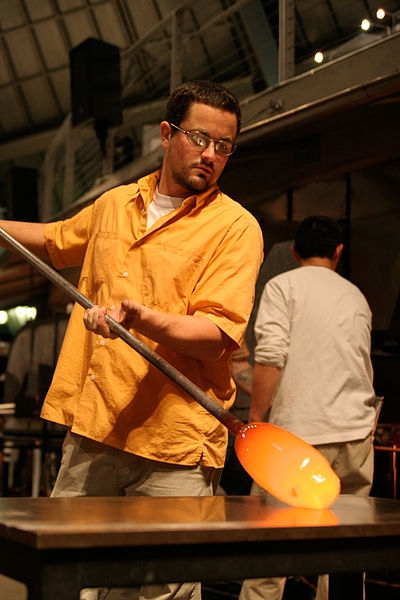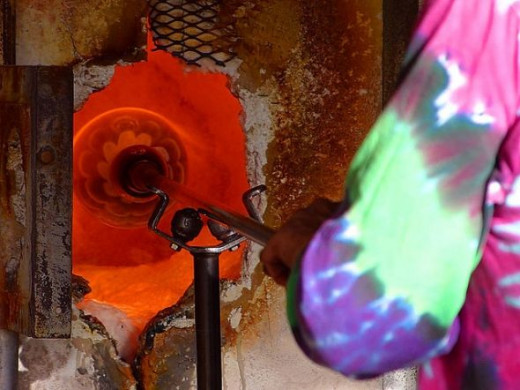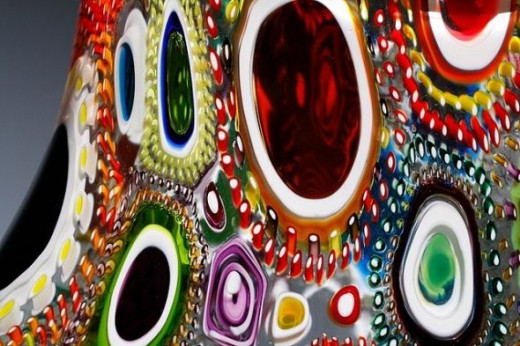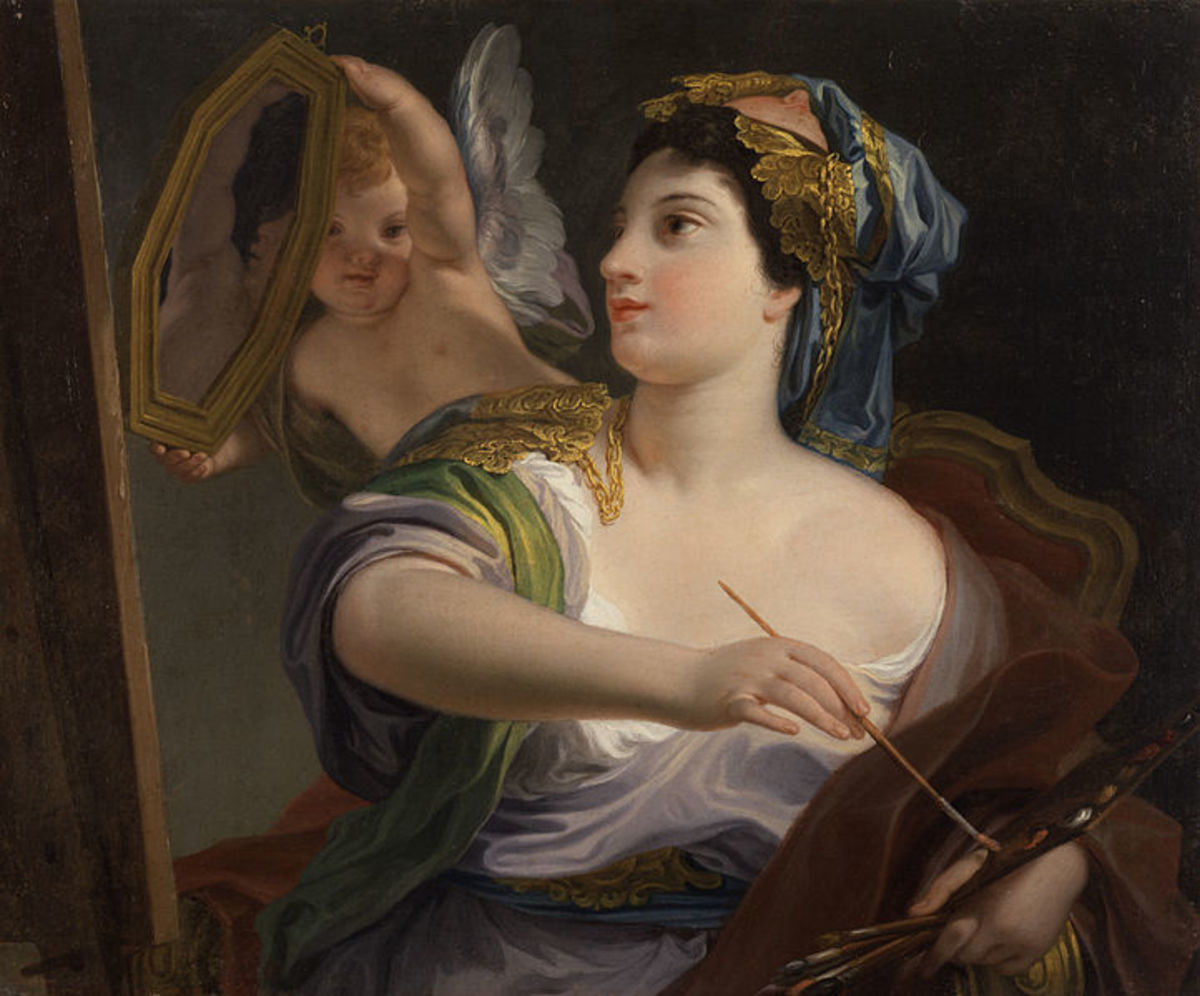Amazing Liquid of Antiquity

A modern servant in a thousand forms.
What liquid may be used for art, engineering and architecture? What is this liquid that is so widely used in the transportation industry, visual industry and yet is also used in hospitals and homes? We are surrounded by it, it is surpassed by few other materials, it is the liquid of antiquity - glass.
Yes, glass is liquid in its molten state. When formed from a white-hot mixture of molten ingredients its atoms and molecules retain the random pattern of a liquid even though it becomes as rigid as ordinary solids.
Nature makes its own glass. The heat, when lightning strikes the silica sand on a beach, forms natural glass called fugurite. Fulgurites do not create glass, the kind you can drink out of, as they are not of the right strength and are not exactly glass, but are a glass-like substance.
Volcanic heat from the earth's core melts silica sand and produces what is called obsidian.
Glass is a unique substance in that it doesn't produce crystals when it cools. Instead it becomes viscose like toffee. This inherent quality allows glass to be blown, pulled, twisted and shaped making glass one of our most versatile and valuable servants.
Photo CreditAncient Murano Glass - Beads
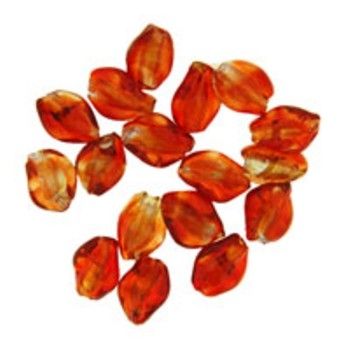
Glassmaking is one of the most ancient industries. Venice was "the only glassmaking centre capable of providing 'works of art' in blown glass, in Europe during the 13th and 14th centuries," says the book Glass in Murano.
These Venetian products were exported from the eastern Mediterranean to Northern Europe. It is reported that in 1399, King Richard II of England allowed two Venetian galleys moored in the port of London to sell glassware and also that the French nobility possessed Venetian glass. Today Murano is well known for their mirrors, chandeliers, gold and enamel decorations,fine figurines, crystal, imitation gemstones, and many other objects with intricate patterns.
Our Modern Glass

Glass is not only ancient but also very modern. After centuries of use, man recognises that in the future there will be ever so many more uses for glass that haven't even been explored yet. In fact, it was not until 1903 that a glass bottle was produced entirely by automation but since then increased knowledge and better means to utilize this amazing liquid have allowed mass production to transform glass from a treasured luxury to a servant in myriads of forms.
I recently read about glass research being performed that may soon help the visually impaired much better than the glasses now available for them.
Heated to 2,800 degrees - That's Hot!
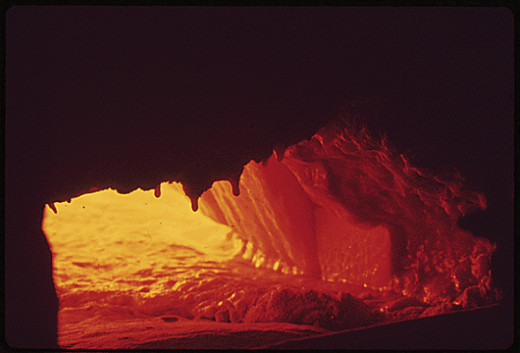
The basic ingredients of glass is still the same as it has been for thousands of years. Silica sand, lime and soda still make about 90 percent of the world's glass. Today giant furnaces can hold a batch of more than 1,000 tons of molten glass. The furnace must be heated to about 2,800 degrees Fahrenheit! Now, that's Hot!
Automation - In seconds .. a batch
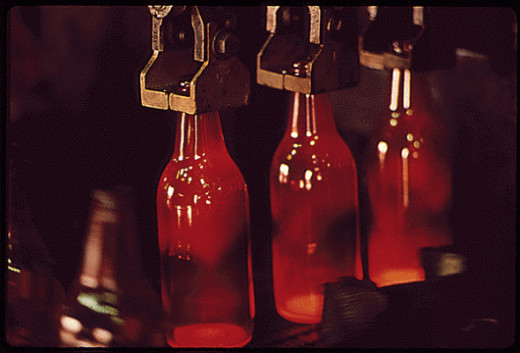
Beautiful Venetian glassware did much to enhance the popularity of glass, but glassmaking was by no means an easy task. The book A Short History of Glass refers to a publication of 1713 that describes what it was like. "The men stand continually half-naked in freezing winter weather near very hot furnaces . . . They shrivel because their nature and substance . . . is burnt up and destroyed by the excessive heat." In later years glass cutters polished glass using a rotating wheel and abrasive powders.
Now when bottles are being made, blobs of glass fall from the furnace into "blank molds" fast! A plunger forces the glass into the shape of the initial mold and the glass is then transferred to a "finishing mold" where compressed air blows it into the final shape. Metal jaws swing open, and out comes the container, still glowing red, about six seconds since the glass left the furnace!
Window Glass - Float Glass & History of Window Glass

Float glass is a sheet of glass made by floating molten glass on a bed of molten metal, typically tin, although lead and various low melting point alloys were used in the past. This method gives the sheet uniform thickness and very flat surfaces. Modern windows are made from float glass. Most float glass is soda-lime glass, but relatively minor quantities of specialty borosilicate[1] and flat panel display glass are also produced using the float glass process.[2] The float glass process is also known as the Pilkington process, named after the British glass manufacturer Pilkington, which pioneered
Article from: Wikipedia, the free encyclopedia
Modern Glass uses
Artistic and historic techniques
Beadmaking · Blowing · Blown plate · Broad sheet · Caneworking · Crown glass · Cylinder blown sheet · Engraving · Etching · Fourcault process ·
Fusing · Lampworking · Machine drawn cylinder sheet · Millefiori · Polished plate · Slumping · Stained glass fusing · Stained glass production
Glass Art by Dale Chihuly - American glass sculptor and entrepreneur.
Find out more about this glass artist. Dale Chihuly
Blown Glass
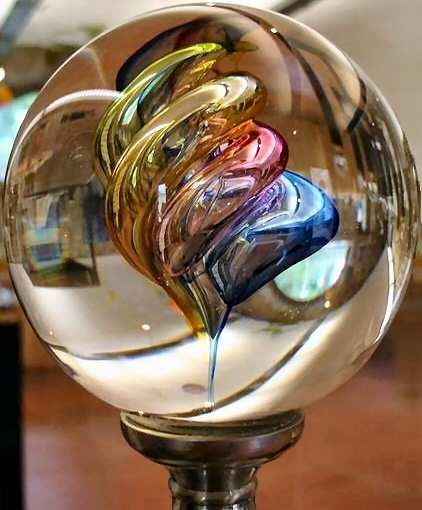
GNU Free Documentation License, Version 1.2 Wikipedia
Have you ever had the chance to watch a glassblower? I must say, I am addicted to blown glass and every chance I get I watch the glassblowers for as long as I can.
My husband and I had a chance to watch glassblowers in Orlando, Florida. We had rented a suite right on the canal. The day was bright and beautiful so we decided to walk along the canal to see what we could discover. We walked up and over a stone bridge (maybe it was brick .. I'll have to have a look at our pictures.) Not far from where we were staying, the glassblowers were practicing their trade in a little shop. I was truly enthralled with the little piggies and rearing horses and other small glass pieces. They were very cute. Besides the small items there were also glass ships in glass bottles, beautiful urns and I just loved the carousel. Using a few simple tools and traditional skills of an ancient craft, these artisans persuaded the liquid into articles of intricacy and beauty beyond the reach of automation. I was in awe!
To me, the blowpipe looked long and clumsy, but to the glassblower it is and important tool.
Glass was gathered on the end of a four foot long blowpipe much like rolling spaghetti on a fork. A puff of breath was cast and trapped in the pipe. As the trapped air moved toward the hot glass it heated up and expanded. When it hit the hot glass it inflated.
The gatherer shaped the hot glass by rolling it on an iron plate called a "marver.
Various workers added their skill to shape the glass, rotating the blowpipe constantly to keep the soft form from sagging out of shape. Swinging the blowpipe elongated the glass; rapid spinning flattened it out. Shaping tools spread an open end in a narrow neck and flattened edges.
Size, shape and thickness depend upon the air blown into the glass, the angle at which the blowpipe is held and the rate at which the glass is allowed to cool. From time to time the glass must be returned to the "glory hole," a reheating furnace, to keep it hot enough to be workable.
Throughout the operation the watchful eye of the shop's master blower was on the operation. As the shop's master blower he handles the more difficult jobs himself, relying upon many years of acquired skill to utilize the fluid, graceful motion of the glass to achieve clean, flowing lines. When he was satisfied with the piece, it was placed in the annealing oven to be gradually cooled.
I found out how to tell if the glass is genuine handmade glass. During the final forming the glass is attached to a long, solid rod called the"pontil." It leaves on some pieces a shallow depression, which is an indication of genuine handmade glass.
I wanted to take some glassware home with us, but since we were travelling by airplane I thought better of it. (I once had a beautiful crystal vase smashed to smithereens during just a short jaunt of an airplane.)
Glass Art - to start your collection.
Here are a few lovely vases but there is a large selection to choose from.
Glass in a thousand forms. - Well a few - I will add more in the future
Click thumbnail to view full-size



Credits for the above photos.
* The Blowpipe Photo Credit
* Glass Artist J.P. Canlis Bamboo Framing Photo Credit
* Blowpipe and "Glory Hole" Public Domain Photo by: User:Y6y6y6
* Blown glass utilizing murrine technique. Created by: David Patchen
Over 100,000 formulas developed - for glass
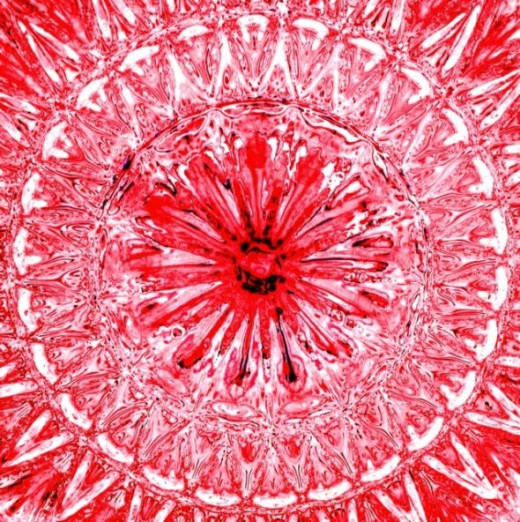
The new families of fiber glass and glass ceramics appear as richly versatile as their ancient parent! Variations of glass are used as insulators for electrical circuits, neon lights and precision optical lenses. Pure silica glass makes mirrors for satellite telescopes and laser-beam reflectors. Special glass serves as space vehicles windows.
Other special formulas produce colored glass panels, building blocks and insulation to decorate and protect modern buildings. Tempered and chemically toughened glasses add to your safety. (Colored glass protects your eyes.)
Indeed, this amazing liquid of antiquity is your modern servant in a thousand forms, asking in return only an occasional cleaning that its brilliance might continue to shine bright.
Modern Glass use

This lens won the coveted Purple Star Award
Thank you to everyone who made this possible.
According to the Purple Star Program, purple stars are awarded to Lenses that are:
* Masterpiece lenses.
* Lenses making a name for themselves.
* Lenses trying new things.
What an honour!
Thank you!
~LaraineRose
I hope that you have enjoyed this lens.
Did you enjoy your visit to this lens?

If you want to make a lens ..
Try it - you'll like it!
If you are interested in how to publish a page like this, it is really quite easy. Just Click Here to begin...open a free account and start your own "lens" here on squidoo on a topic of your choice.
A Roman Diatret Glass at Wikipedia .. Artist - Unknown
I have enjoyed researching this ancient/modern industry. I believe that glass is nothing short of miraculous. I hope that you have found this lens enjoyable, but if not enjoyable, at least informative.
I will be pleased if you will leave a comment.
Thank you,
LaraineRose








